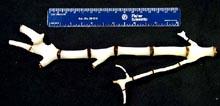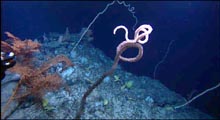
Coral polyps and tissue have been removed from a branch of a bamboo coral to show the node-internode structure of the skeleton. The short, dark nodes are composed of protein and the longer white internodes are made of calcium carbonate. Click image for larger view and image credit.
Will the real Lepidisis please stand up?
September 1 , 2005
Scott C. France
University of Louisiana at Lafayette
![]() See a video of how coral fossils tell a story. (Quicktime, 1.8 Mb.)
See a video of how coral fossils tell a story. (Quicktime, 1.8 Mb.)
A popular TV game show in the 1960s was 'What's My Line?'. On the show, three guests all claimed to be the same person -- someone with a unique job or claim-to-fame -- and a panel of celebrities had to determine which of the guests was the real one by asking a series of yes-or-no questions. We have a similar problem with some deep-sea corals.
For example, a common sight on deep seamounts are bamboo corals, so named because of their skeleton, which alternates short, dark proteinaceaous nodes with longer white calcified internodes. Bamboo corals come in a variety of shapes, sizes and colors, and a commonly encountered form is an unbranched whip, some standing more than 4 meters (13 feet) tall. Most researchers refer to these bamboo whips by the name Lepidisis, which is a scientific name for the genus (see log by Mercer Brugler for information on scientific names). However, in the academic literature there is some confusion about whether the name Lepidisis refers only to unbranched whip-like colonies, or also includes some branched bamboo corals. Another question is whether there is more than one species of bamboo whip out here on the seamounts. In our research, we are using genetics to help sort out these questions.

Tall, whip-like Lepidisis bamboo corals with pigtail coils and a rust-colored black coral leave the impression of an otherworldly forest on Manning Seamount. Click image for larger view and image credit.
During the Mountains in the Sea 2004 expedition, we collected five Lepidisis bamboo coral whips. Back in the lab at the University of Louisiana we extracted the DNA from tissue samples of these colonies, and obtained DNA sequences. We compared these DNA sequences to each other and to additional bamboo corals we have collected from other locations. We were somewhat surprised to discover that there were two very distinct (at least in their genetic signature) types of bamboo coral whips, and one of them is evolutionarily close to highly branched bamboo corals. The other type is interesting in that the two colonies we collected on the New England Seamounts were forked near the tip. When we collected them, we weren't sure if the fork was the result of a wound or some other factor, but our genetic data reveal they are a distinct species. Apart from being able to say exactly how many species there are on these seamounts, why is this result important?
My colleagues on the expedition are conducting a variety of other biological analyses of these bamboo corals, and they need to be sure that all of their measurements are made on the same species. As an analogy, if you were making scientific measurements of leopards, you wouldn't want to accidentally measure a jaguar. They look similar, but their physiologies may differ in significant ways. As part of our expedition, Lauren Mullineaux, of the Woods Hole Oceanographic Institution, is estimating the ages of Lepidisis to learn how fast they grow and how long they live. Our genetic data suggest her measurements should avoid the forked-tip Lepidisis and focus on the more commonly seen unforked form. On the other hand, I will attempt to collect both forms on different seamounts to verify our initial results and to determine which is the real Lepidisis.
Sign up for the Ocean Explorer E-mail Update List.
























